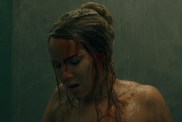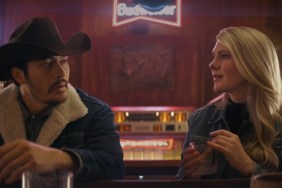Last week, legendary Russian cinematographer Vadim Yusov was honored with a Lifetime Achievement Award at the 20th annual Plus Camerimage festival in Bydgoszcz, Poland and ComingSoon.net was on hand to speak (through a translator) with the man responsible for the photography in unforgettable celluloid masterworks like Ivan’s Childhood, Andrei Rublev and Solaris.
Now 83, a young Yusov met an even younger Andrei Tarkovsky in 1960, teaming for the short stage play adaptation “The Steamroller and the Violin.” After continuing their creative partnership for over a decade, Tarkovksy and Yusov parted ways just prior to 1975’s The Mirror. Yusov, who continues to work on feature films to this day, has also served as the head of Russia’s Gerasimov Insitute of Cinematography since 1982. In the below interview, Yusov discusses his career, laughs about how he’s responsible for some of Andrei Rublev‘s phallic mis-en-scene and offers the reminder that true filmmaking is an ongoing study into the relationship between the viewer and the subtlety and sublimity of any given work.
CS: You’ve been involved in so many iconic films, particularly in your work with Andrei Tarkovsky. Do you have a personal favorite?
Vadim Yusov: No, but I will reply to you more clearly. I love all of my movies, not because of the result but because of the process. When you work together with a creative team, you’re friends with those people and you have the same goal. If you look, for example, at “Andrei Rublev,” it was made at a time when Tarkovsky was very young. He wasn’t very visible. At the same time, however, everyone felt a great respect for him. Even the writer would look at Tarkovsky in a way that showed he really respected him. There was something in him as a person that brought about this respect. For example, all of those things are still in me. All those memories and feelings are still in me. There is one movie called “Krasnye kolokola.” This movie was made in a very difficult time when we had a very recent revolution in Russia. This movie was created by three different countries: Italy, the Soviet Union and Mexico. This movie wasn’t really seen by very many people. It was very difficult because I would sometimes have to shoot 10,000 people per scene per day. It was a huge production. At the same time, the work is very dear to me. It is a question of the process of working. It’s not about the result, but the process and the people I was working with.
CS: There are shots in your films that have achieved worldwide recognition for their unearthly, spirtual beauty. Are you able to look at your own work and feel a similar impact from the images you captured or does the fact that you shot them make you overly critical of your accomplishments?
Yusov: [Laughs and reaches out to offer a high five] Your words are very complimentary. How can I can talk about it? You say that you prize me and how can I comment on that? I have to tell you, though, that I don’t even really know if you’ve seen the works that I have done. You are young and I’m not going to check you. But if there are certain scenes that you want to talk about, I can tell you about the things that are really hidden from the viewers. But I’m not trying to tell you that you should remember any of my scenes. I have students and I hate telling them, “No, no. You haven’t seen this picture.” When a young person enters the university, they often come to me. I look at the pictures that they take. I ask, “How did you take this shot?” When they start to answer the question, I know if they really took the picture or not. When you talk about portraits and certain lights, the person who has a camera in his hand could not forget how he shot the image. I ask, “Where was your source of light?” The student tells me, “This is where the light was.” I say, “This is not possible. Look, where is the shadow from the head? You didn’t take this picture.” “I did take this picture!”. “No,” I tell them, “You may have pressed the button, but you had someone who was a professional place the light for you. You were shooting this particular photo in a studio and everything is very professional.”
CS: Your films with Tarkovsky all seem incredibly precise. How much creative freedom were you allowed in your collaborations?
Yusov: For example, there are maybe three or four places in “Andrei Rublev” where I made the sketches and the objects were used as I placed them. If we had the DVD right now, I would stop it and show you. Here is this abstract object. It’s not functional, but all the movement of the scene is around them. Even the director isn’t asking questions. He’s just trusting me and letting the action go around these poles, which are rather phallic and part of the mise-en-scene. The actor who was performing is still alive and he never knew it. Tarkovsky knew about it, but he accepted it as my surrealistic desire to bring something in. oftentimes, people never noticed it. I was once shooting with Ivan Dykhovichnyy, who also is no longer alive. There is a change in lighting during one shot and one scene. The professional people ask me, “Did you see the change of the color in one scene from red to green?” There is no editing. It’s just one scene and one take. No one notices because of the action that is going on. You can use that for certain purposes. You can use light to change the face of the actor. Sometimes it makes sense in the scene, like if a person is driving or moving. But what about when a person is still and the light is changing without reason? I’m very interested in this. I can’t tell you, exactly, how that influences somebody’s subconscious, but it’s very interesting to explore how it does. But I’m not original in this kind of discussion. The science of cinema has been asking this question for a very long time. I was in Japan and visited a scientific center. They were showing the same scene, synchronized, in two different rooms but with different quality assigned to each image. In one room, the image is perfectly clear and, in the other, it’s much more foggy. The audiences are being monitored with wires that gives signals on their emotions. When the image is clearer, they found that the emotions are stronger. This is something that still isn’t fully understood. I don’t fully understand myself. I am not a scientist.
CS: I was reading about the complicated mechanics that allowed for the weightless scenes in “Solaris.” Is that something that came from you or from Tarkovsky?
Yusov: We filmed that with two different cranes to make it feel as though they were weightless. With computers today, you could do that very simply. I did a documentary one time where I really filmed in weightless conditions. It was the place where they train the cosmonauts, so I have that experience of no gravity. Yes, that was my construction.










